Do you have a question about the MOTO GUZZI V7 III and is the answer not in the manual?
Instructions for safe operation and precautions before riding.
Importance of the manual and contacting the dealer for information.
Hazards of carbon monoxide from exhaust fumes.
Hazards of flammable fuel and safe refueling procedures.
Engine and exhaust components become very hot after use.
Illuminating warning lights indicate system abnormalities.
Proper handling and disposal of used oil to prevent skin damage.
Brake fluid can damage surfaces and eyes.
Battery electrolyte is toxic, corrosive, and can cause burns.
Avoid swapping connectors; contact info for warranty and safety.
Familiarize with local road rules before riding.
Exhaust system conforms to EPA noise standards.
Combustion creates carbon monoxide and hydrocarbons.
Prohibits tampering with exhaust system and warning labels.
Symptoms of emission system problems.
Diagrams showing the location of warning labels on the vehicle.
Details about emission control system warranty coverage.
Coverage periods for different motorcycle classes.
USA market emission control system warranty declaration.
Owner's responsibility for maintenance and record-keeping.
Warranty repairs must be done at an Official Moto Guzzi Dealership.
What the emission control system warranty does not cover.
Moto Guzzi's limited responsibilities under the emission warranty.
Provides information on legal rights that may vary by state.
States this warranty complements the manufacturer's limited vehicle warranty.
Diagrams identifying major vehicle components with numbered labels.
Details of the motorcycle's dashboard and controls.
Description of the instrument panel indicators and display.
Explanation of various warning lights and their meanings.
Information displayed on the LCD screen, including ice alarm.
Warning when external temperature drops to 3°C / 37.4°F.
Explains the wrench icon for service reminders.
How fault descriptions are shown on the display with warning lights.
Explains oil pressure and sensor alarm messages and actions.
How to use the MODE button to navigate display information.
Describes the LOCK, OFF, and ON positions of the ignition switch.
Procedure for locking the steering and a warning about its use.
How to activate the horn.
How to operate the turn signal switch and warning for burnt bulbs.
Operation of the high and low beam selector switch.
Using the passing button for high beam flashing.
How to start the engine and operate the MGCT system.
Function of the engine stop switch as safety/emergency control.
How the ABS system works and its benefits.
How the MGCT system aids riding and stability.
Information about the two-seater saddle and passenger seat.
Procedure for opening and locking the motorcycle saddle.
Information regarding the saddle guard (if available).
Location of chassis and engine numbers for identification.
Importance and procedure for pre-ride checks for safety.
Safe procedures for refueling the vehicle with gasoline.
How to adjust the rear shock absorbers for load and ride comfort.
Procedure to check the front fork for smooth operation and leaks.
How to check and adjust the clearance of the front brake lever.
Information on rear brake pedal adjustment.
How to adjust the clutch lever for optimal operation.
Information regarding gear pedal adjustment.
Rules for running-in the new vehicle for durability.
Safe procedures for starting the engine, considering exhaust fumes.
How to move off and ride the motorcycle safely.
How to safely stop the engine and the vehicle.
Guidelines for parking the vehicle safely on firm, level ground.
Function of the catalytic muffler and warnings about unleaded gasoline.
How to use the side stand safely and warnings about its use.
Recommendations for preventing vehicle theft.
Comprehensive safety rules for riding the motorcycle.
Importance of proper protective clothing for rider visibility and safety.
Owner's responsibility for accessory choice and installation.
Guidelines for securing luggage and avoiding overloading.
Safety rules for mounting and dismounting the vehicle.
General advice on maintenance and when to consult a dealer.
Importance of correct engine oil level for safety and performance.
Step-by-step guide to checking the engine oil level.
Procedure for topping off engine oil and recommended type.
Advice on engine oil and filter replacement, consult dealer if complex.
How to check and top up the bevel gear pair oil level.
Contact dealer for gearbox oil demounting, checking, and replacing.
Information on tire types, pressure, and wear indicators.
Contact dealer for spark plug removal, check, and replacement.
Procedure for removing the side fairing/panel.
Contact dealer for air filter removal, check, and replacement.
How to check brake fluid levels for front and rear brakes.
Contact dealer for topping up brake system fluid.
Step-by-step guide for removing and installing a new battery.
Notes on maintenance-free batteries and electrolyte checks.
Procedure and specifications for charging the motorcycle battery.
Recommendations for battery care during long periods of inactivity.
How to check and replace fuses, and fuse distribution.
Warnings about using functional lights and proper adjustment.
How to check and adjust the direction of the front light beam.
Procedure for removing and replacing front turn signal bulbs.
Procedure for removing and replacing rear light bulbs.
Procedure for removing and replacing rear turn signal bulbs.
How to remove and adjust the rear-view mirrors.
Importance of brake system and checking discs and pads.
Steps to prepare the vehicle for periods of inactivity.
Recommendations for cleaning the motorcycle and its parts.
Guidelines for safely transporting the motorcycle.
Physical dimensions and weight specifications of the vehicle.
Details about the engine type, cylinders, and capacity.
Information on the gearbox type and number of speeds.
Fuel tank and reserve capacity specifications.
Details on primary drive and gear ratios.
Information on fuel injection type and fuel used.
Description of the chassis type and steering rake angle.
Specifications for front and rear suspension travel and types.
Specifications for front and rear brake disc and caliper.
Information on wheel rim types and sizes.
Tire sizes and inflation pressures.
Spark plug model and electrode gap specifications.
Specifications for battery, alternator, and fuses.
Types of indicator lamps used on the vehicle (LED).
Description of the tools included in the motorcycle's toolkit.
Table outlining scheduled maintenance tasks and intervals.
List of recommended lubricants and fluids for maintenance.
Information about available accessories and clothing.
Instructions for safe operation and precautions before riding.
Importance of the manual and contacting the dealer for information.
Hazards of carbon monoxide from exhaust fumes.
Hazards of flammable fuel and safe refueling procedures.
Engine and exhaust components become very hot after use.
Illuminating warning lights indicate system abnormalities.
Proper handling and disposal of used oil to prevent skin damage.
Brake fluid can damage surfaces and eyes.
Battery electrolyte is toxic, corrosive, and can cause burns.
Avoid swapping connectors; contact info for warranty and safety.
Familiarize with local road rules before riding.
Exhaust system conforms to EPA noise standards.
Combustion creates carbon monoxide and hydrocarbons.
Prohibits tampering with exhaust system and warning labels.
Symptoms of emission system problems.
Diagrams showing the location of warning labels on the vehicle.
Details about emission control system warranty coverage.
Coverage periods for different motorcycle classes.
USA market emission control system warranty declaration.
Owner's responsibility for maintenance and record-keeping.
Warranty repairs must be done at an Official Moto Guzzi Dealership.
What the emission control system warranty does not cover.
Moto Guzzi's limited responsibilities under the emission warranty.
Provides information on legal rights that may vary by state.
States this warranty complements the manufacturer's limited vehicle warranty.
Diagrams identifying major vehicle components with numbered labels.
Details of the motorcycle's dashboard and controls.
Description of the instrument panel indicators and display.
Explanation of various warning lights and their meanings.
Information displayed on the LCD screen, including ice alarm.
Warning when external temperature drops to 3°C / 37.4°F.
Explains the wrench icon for service reminders.
How fault descriptions are shown on the display with warning lights.
Explains oil pressure and sensor alarm messages and actions.
How to use the MODE button to navigate display information.
Describes the LOCK, OFF, and ON positions of the ignition switch.
Procedure for locking the steering and a warning about its use.
How to activate the horn.
How to operate the turn signal switch and warning for burnt bulbs.
Operation of the high and low beam selector switch.
Using the passing button for high beam flashing.
How to start the engine and operate the MGCT system.
Function of the engine stop switch as safety/emergency control.
How the ABS system works and its benefits.
How the MGCT system aids riding and stability.
Information about the two-seater saddle and passenger seat.
Procedure for opening and locking the motorcycle saddle.
Information regarding the saddle guard (if available).
Location of chassis and engine numbers for identification.
Importance and procedure for pre-ride checks for safety.
Safe procedures for refueling the vehicle with gasoline.
How to adjust the rear shock absorbers for load and ride comfort.
Procedure to check the front fork for smooth operation and leaks.
How to check and adjust the clearance of the front brake lever.
Information on rear brake pedal adjustment.
How to adjust the clutch lever for optimal operation.
Information regarding gear pedal adjustment.
Rules for running-in the new vehicle for durability.
Safe procedures for starting the engine, considering exhaust fumes.
How to move off and ride the motorcycle safely.
How to safely stop the engine and the vehicle.
Guidelines for parking the vehicle safely on firm, level ground.
Function of the catalytic muffler and warnings about unleaded gasoline.
How to use the side stand safely and warnings about its use.
Recommendations for preventing vehicle theft.
Comprehensive safety rules for riding the motorcycle.
Importance of proper protective clothing for rider visibility and safety.
Owner's responsibility for accessory choice and installation.
Guidelines for securing luggage and avoiding overloading.
Safety rules for mounting and dismounting the vehicle.
General advice on maintenance and when to consult a dealer.
Importance of correct engine oil level for safety and performance.
Step-by-step guide to checking the engine oil level.
Procedure for topping off engine oil and recommended type.
Advice on engine oil and filter replacement, consult dealer if complex.
How to check and top up the bevel gear pair oil level.
Contact dealer for gearbox oil demounting, checking, and replacing.
Information on tire types, pressure, and wear indicators.
Contact dealer for spark plug removal, check, and replacement.
Procedure for removing the side fairing/panel.
Contact dealer for air filter removal, check, and replacement.
How to check brake fluid levels for front and rear brakes.
Contact dealer for topping up brake system fluid.
Step-by-step guide for removing and installing a new battery.
Notes on maintenance-free batteries and electrolyte checks.
Procedure and specifications for charging the motorcycle battery.
Recommendations for battery care during long periods of inactivity.
How to check and replace fuses, and fuse distribution.
Warnings about using functional lights and proper adjustment.
How to check and adjust the direction of the front light beam.
Procedure for removing and replacing front turn signal bulbs.
Procedure for removing and replacing rear light bulbs.
Procedure for removing and replacing rear turn signal bulbs.
How to remove and adjust the rear-view mirrors.
Importance of brake system and checking discs and pads.
Steps to prepare the vehicle for periods of inactivity.
Recommendations for cleaning the motorcycle and its parts.
Guidelines for safely transporting the motorcycle.
Physical dimensions and weight specifications of the vehicle.
Details about the engine type, cylinders, and capacity.
Information on the gearbox type and number of speeds.
Fuel tank and reserve capacity specifications.
Details on primary drive and gear ratios.
Information on fuel injection type and fuel used.
Description of the chassis type and steering rake angle.
Specifications for front and rear suspension travel and types.
Specifications for front and rear brake disc and caliper.
Information on wheel rim types and sizes.
Tire sizes and inflation pressures.
Spark plug model and electrode gap specifications.
Specifications for battery, alternator, and fuses.
Types of indicator lamps used on the vehicle (LED).
Description of the tools included in the motorcycle's toolkit.
Table outlining scheduled maintenance tasks and intervals.
List of recommended lubricants and fluids for maintenance.
Information about available accessories and clothing.
| Displacement | 744 cc |
|---|---|
| Transmission | 6-speed |
| Fuel System | Electronic fuel injection |
| Final Drive | Shaft drive |
| ABS | Standard |
| Wheelbase | 1, 463 mm |
| Seat Height | 770 mm |
| Engine Type | 90° V-twin |
| Max Power | 52 hp (38 kW) @ 6, 200 rpm |
| Max Torque | 60 Nm at 4900 rpm |
| Cooling System | Air-cooled |
| Front Suspension | 40 mm telescopic fork |
| Rear Suspension | Dual shock absorbers |
| Front Brake | 320 mm disc, 4-piston caliper |
| Rear Brake | 260 mm disc, 2-piston caliper |
| Fuel Tank Capacity | 21 liters |
| Dry Weight | 189 kg |

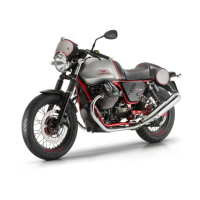


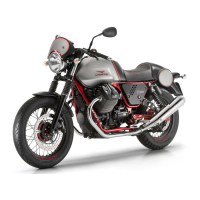
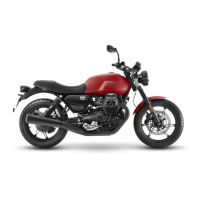
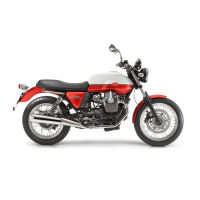
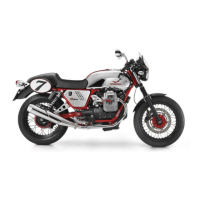
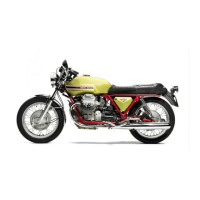

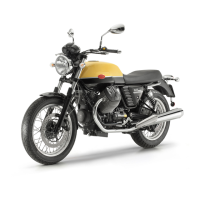
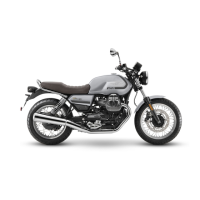
